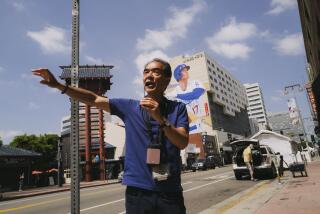For Sale: Japan Property, Cheap
- Share via
TOKYO — “For such a small building, I don’t know why they used so much marble,” says Sam Kaneko, president of the L.A.-based DaVinci investment group, marveling at the wastefulness as he surveys one of the 16 Tokyo office buildings he recently purchased. “It’s typical [speculative] bubble stuff.”
The rounded shape, small base and odd three-story indent midway up its face leave each floor of this building in Tokyo’s pricey Shinjuky area with just enough space for a few workers and a small reception space. The previous owner, imprisoned for tax evasion, didn’t put a yen into plumbing or electrical upkeep. And nearly half the nine floors were either empty or filled with deadbeat tenants when DaVinci took the building over.
Fifteen months later, however, the bad tenants are out, the building is full and DaVinci is getting a double-digit return on its $5-million investment. The group hopes to buy 20 more buildings by year-end.
DaVinci is just one of dozens of American hedge funds, pension funds, vulture funds, real estate trusts and good old carpetbaggers flocking to Japan these days, lured by the promise of real estate at fire sale prices.
In the fiscal year ended March 31, foreigners--mostly Americans--bought $1.25 billion in Japanese real estate, up 150% over fiscal 1998, and an estimated $3.5 billion to $5 billion in property-related bad loans.
The numbers could be a lot higher if there was more to buy, according to some foreigners. Japan’s well-publicized economic problems notwithstanding, Japanese companies are doing everything possible to avoid selling their crown jewels.
But America’s presence here is growing dramatically, tipping the seesaw in the other direction as a remarkable decade ends.
In the late 1980s, Japanese buyers were picking up Arco Plaza, Pebble Beach Golf Links and Rockefeller Center like pennies in a parking lot. By the mid-1990s, recession-bound, they were unloading much of the $77 billion in U.S. trophy properties they’d acquired.
Now, with barriers to foreign investment lowered, Americans have set their sights on Japanese real estate--and are introducing American innovations.
At stake is more than a Yankee windfall, though. Selling off distressed property is essential if Japan is going to restore the health of its battered banks and reverse its nine-year economic slide.
Among several recent high-profile deals, multinational insurance company American International Group bought the Japan Energy headquarters building in central Tokyo for $583 million, in partnership with Mitsui Real Estate, and Goldman Sachs acquired the Toho Mutual Life headquarters for $250 million.
L.A.-based investment fund Colony Capital and real estate firm Kennedy-Wilson snapped up a 20-story office building in the Tokyo suburb of Kawasaki for $91 million.
On other fronts, Morgan Stanley, Goldman Sachs and opportunity funds Lonestar, Cerebus and L.A.’s Secured Capital each reportedly purchased close to $1 billion of property-backed bad loans priced at 10 to 15 cents on the dollar.
They are betting on the long haul, since the market continues to fall. Land values, now just 20% of their late-1980s peak, have been dropping for eight straight years.
“In California, the term used was ‘real estate depression,’ ” says Mark Grinis, a certified public accountant in EBY Kenneth Leventhal’s Tokyo office. “If there was a term here stronger than ‘depression,’ it would be appropriate.”
Whereas better buildings in prestigious Tokyo and Osaka locations are holding their values relatively well, smaller sites elsewhere have suffered badly, many having vacancy rates of 25% or higher. And announcements of thousands of jobs to be cut over the next several years by Sony, NEC, NTT and others make continued declines likely for the near term.
In this environment, U.S. bottom fishers are better positioned than many European and Asian rivals because of their large war chests, willingness to spend and hard-won expertise gained during the savings-and-loan crisis and Southern California slide.
Along the way, Americans are shaking up Japan’s tradition-bound property market.
“Foreign players are changing the way business is done,” said Hideaki Fukushima, senior vice president of structured finance with Japan’s DKB Bank. “Of course, in order to succeed, they also have to know something about Japan.”
*
One change is the introduction of more objective valuation methods. Foreign buyers are insisting that the return on investment in Japanese real estate be in line with those of other financial assets. Traditionally, Japan has ignored things such as cash flow analysis in favor of less objective factors focused on land’s perceived intrinsic value.
Big American players are also helping introduce more sophisticated financing methods in Japan, such as mortgage-backed securities. Over time, this should make borrowing easier and lessen the dependence on banks, expanding their options.
In some cases, foreigners are also able to break up logjams because they aren’t subject to Japanese social norms. An American company, for instance, might buy a $1-million distressed bank loan for $150,000 and sell it back to the landlord for $225,000. In the process, the bank avoids foreclosing on a valued customer, the landlord gets out of debt and the American makes a quick profit. This allows the Japanese partners to save face in a country that has only slowly acknowledged the depth of its problems.
“You have a nut and bolt that is rusted shut,” said Ronald F. Greenspan, partner with PricewaterhouseCoopers. “What Western capital does is squirt oil to get it turning again. Without it, the economy and the property market stagnate.”
Globalization, foreign investor pressure and the desire to get property markets moving again are also prompting the government to reduce taxes and change laws that put foreign companies at a disadvantage or make bankruptcy recovery difficult for Japanese.
As is usual in Japan, many of these structural changes happen slowly.
A bigger problem for American investors, however, is finding good property to buy. According to a Mitsui study, fewer than 10 prime commercial buildings go on sale annually in Tokyo. That compares with about 200 in Los Angeles.
“Many people arrive saying, ‘I have $1 billion,’ ” says Shuji Tomikawa, a director with Mitsui. “I laugh. Forty people met me last year with $1 billion. If you don’t have a transaction, it’s wasted.”
Premium commercial sites with open floor plans and good amenities rarely come on the market, even now, and they set off intense foreign bidding when they do. The handful of Japanese property giants with the best sites are selling property overseas and getting rid of low-end Japanese properties in a bid to ride out the storm.
In Japan, those include Japan’s famously ugly “pencil buildings”--tall, thin structures built on tiny plots of land and having little floor space.
“Everyone knows about the good properties because you can count them on one hand,” said John Tofflemire, general manager with the Japanese division of CB Richard Ellis. “Everyone’s looking at the same stuff, and there’s not a lot of it.”
The culture of land in Japan, linked to centuries of rice farming, also keeps it off the market. Property is still viewed less as a money-earner than as a monument in which to store your wealth over generations, and it signals your economic clout in the community. Some 25% of Japan’s wealth is held in land, compared with 8% for the U.S.
Thus many companies still cling to their headquarters buildings even though by Western standards the money in them would be better spent on a new chip-making factory or other, more productive investment. Too often, analysts say, selling property is seen as a sign of failure rather than as good management.
“Buy-and-hold is part of the accumulation of economic power,” says Tofflemire. “And when you give up assets, it’s an expression of the loss of power.”
This was reinforced by a long-standing belief that land values only went up. In fact, they did just that every year from 1945 to 1990 except during the 1979 oil crisis. This faith helped drive Tokyo prices to such absurd levels at the height of the 1980s bubble years that the imputed value of Tokyo’s 284-acre Imperial Palace property was greater than all the property in California.
The pencil buildings, meanwhile, reflect another peculiarity of the Japanese market: the traditional difficulty developers face cobbling together sites large enough to support a reasonable layout.
About 55.1% of all Tokyo transactions between 1991 and 1996 involved land parcels of less than 100 square meters. “It can take 10 or 15 years to put together a decent-sized lot,” said Toshihiko Okino, property analyst with Warburg Dillon Read.
*
The cultural importance placed on consensus and avoiding confrontation mean that a single party can stymie a huge project. This is perhaps best illustrated at Tokyo’s Narita airport, where a handful of farmers have held up a badly needed expansion for 25 years.
“If 30 million people can’t have another runway because of a few Japanese farmers, how can we move a noodle shop?” asks Mitsui’s Tomikawa.
Along the way, foreign players are learning to cope with certain hazards that go with the territory, including property occupied by the yakuza, or Japanese organized crime. “Zero-value loans” is the code phrase sometimes given to these sites.
In 1997, Goldman Sachs grabbed what it thought was a great distressed property, says analyst Okino. When it tried to raise the below-market rents, however, its tony downtown business offices were invaded and its employees harassed by yakuza members who resented the pressure. Goldman quickly got the picture.
More to Read
Inside the business of entertainment
The Wide Shot brings you news, analysis and insights on everything from streaming wars to production — and what it all means for the future.
You may occasionally receive promotional content from the Los Angeles Times.










